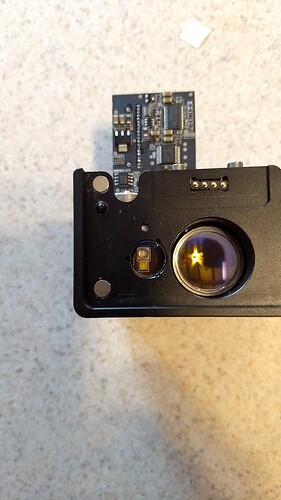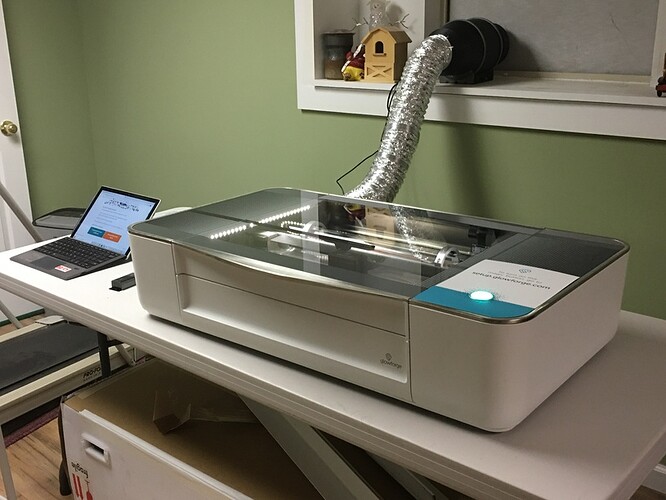it’s scrap material that can be engraved without any effect or off-gassing, and it’s not shiny metal so I don’t run risks of reflective damage. I don’t want to needlessly engrave my honeycomb bed if I don’t have to 
You realize that the honeycomb bed is steel, right?
I would recommend replacing that spring clamp with the screw type hose clamp and then taping it also. The potential is small, but that spiral wire that supports the flex duct passes under any clamp that is used, so right next to the wire there is a minute path under the clamp on both sides of the wire.
The tape is a solution, but a better one might be to wrap the connection flange with a cushion of sorts that allow the wire to embed in it when tightened. Even 6 layers or so of masking tape should be enough to absorb the thickness if the wire.
I have a long exhaust run, and finally got serious about killing every leak, including using silicone to seal every joint, seam and elbow. No more smell. When the smell comes back, I will know it’s time to clean the fan grill of the exhaust fan.
my car is also steel, that doesn’t mean I like to damage it any more than I have to.
My point is that the Glowforge does not have enough power, especially at the correct wavelength to damage steel.
Certainly not enough power but high power CO2 lasers are used to cut steel, so the wavelength isn’t a problem.
every laser I’ve used in a shared space has featured the inevitable “JULIA” or similar that’s been scorched into the bottom of the bed - apparently I’m unique in not wanting my stock engrave “time filler” to not be etched into the bottom of my tray over time 
You will get some char buildup on the grid from the material, but even after running several cuts where the edge of the material was missed there is no damage to the grid on my Glowforge. There is no mark on the bottom of the crumbtray. There just isn’t enough energy in the laser to etch the steel without some type of activator, especially since the laser has been defocused by the time it hits the bottom of the crumb tray.
I think this is a point often missed by people worrying about the reflections from metallic surfaces going back up into the optics. The beam is diverging, so if it hits a flat surface it will just keep on diverging when it is reflected.
The only way it could do any damage is if, by some amazingly low probability, it hit a surface with precisely the right concavity, at precisely normal to the path of the beam, to be focused back onto the surface of the optics.
I personally think the chances of that are vanishingly small in my universe, so I don’t worry about it.
![]()
If a focused beam hits metal it will reflect back to the lens and be diverged the same amount as it was when it came from the lens. Not sure what effect that would have. If the metal was exactly perpendicular it would reflect all the way back to the laser tube.
If it hit an optically flat surface, it would be returning, diverging, at twice the included angle of the original convergent beam. If it then passes back through the exit lens it will still be diverging, but now at the original 'convergent 'angle, and will dissipate by low angle internal reflections on the wall of the laser tube.
It will do no damage whatsoever.
 .
.
Why twice the angle?
If angle of incidence is equal to angle or reflection the outer rays of the beam should simply swap over?
I don’t remember any comment from the company that a reflecting beam will damage the laser itself. Just that a perfect reflection might cause damage. Remember that there is more to the bottom of the head than the laser lens port. Might cause damage elsewhere? There are two other ports in the head bottom. One of which is another camera (not shown here).
You’re right, of course. I managed to turn a half angle into a whole one.
However, fortunately, the power density falls off with the square of the distance.

Until it goes through the lens and then it will be parallel again at a significant proportion of the power density of the raw beam. There is enough power density in the pre focused 40W beam to instantly burn through paper.
I managed to destroy a 1W IR laser diode with a reflection that must have gone back through the lens and then overloaded the mirrors and melted them. It was still a diode but no longer lased.
Of course a CO2 tube is a lot more robust than a laser diode, which is the most delicate semiconductor I have come across.
Below is my current set up. I have a piece of foam that I put in the window with my infinity fan when I’m ready to laser. I remove it and close the window when I’m done for the day.
However, I’m going to be doing acrylic and do NOT want the smell in my basement! I can smell the engraved wood hours after cutting if I go back downstairs.
I’d love to have something more permanent in the window totally sealed and NO smell. I will switch over to the screw-based hinges as you suggested for the pipe. I’m thinking of getting the black pipe from Amazon I see others use.
Any thoughts would be greatly appreciated, thank you!
The booster fan housing itself on mine needed to be sealed also. Your setup looks good! Enjoy your adventure. 
Thank you very much! I’m going to get some tape and seal both ends of the hose, as well as where the booster fan meets the foam in the window. I will also find something to seal the edges of the foam as I did see a smidge of a gap the other day.
One thing I would say is make sure that fan is attached really good to the window side or the wood it is sitting on, I’m sure it would make a big mess if that were to fall on the lid of your machine.
I used caulk to ensure gaps were sealed, everywhere except where the hose plugs onto the machine.

